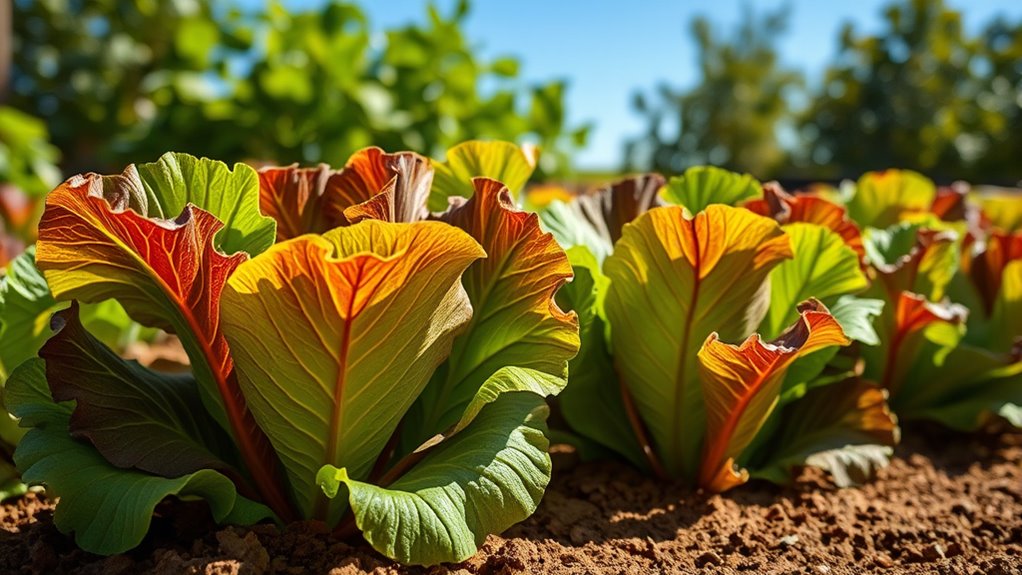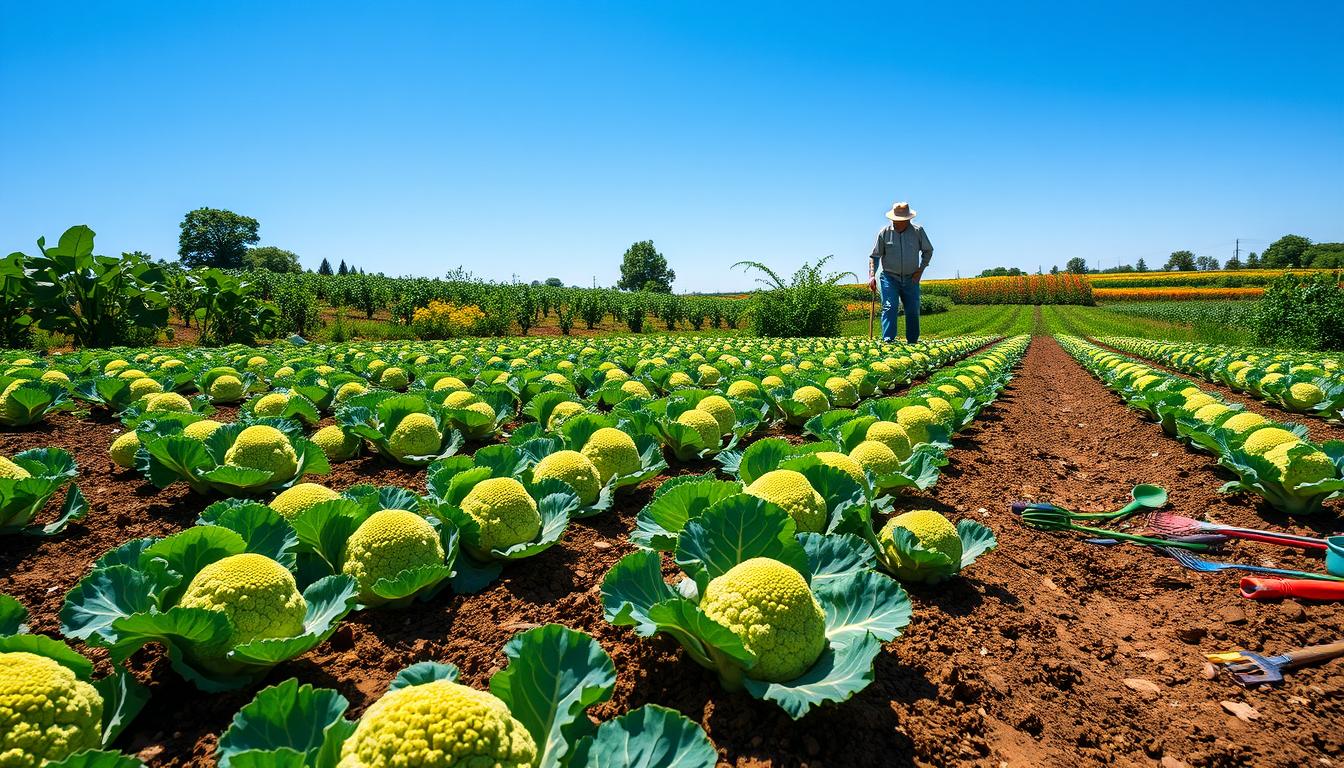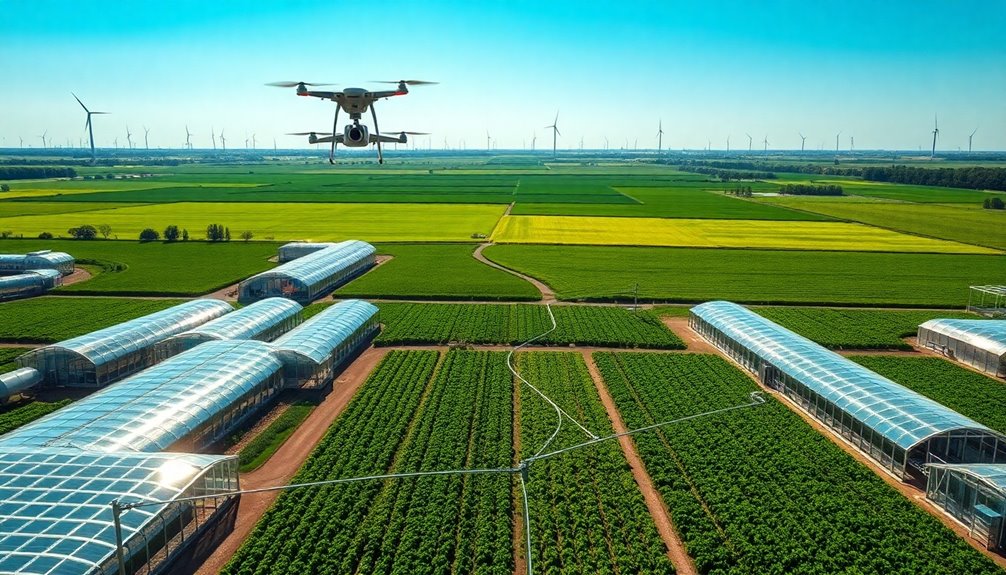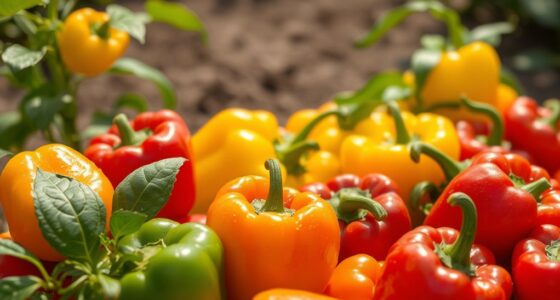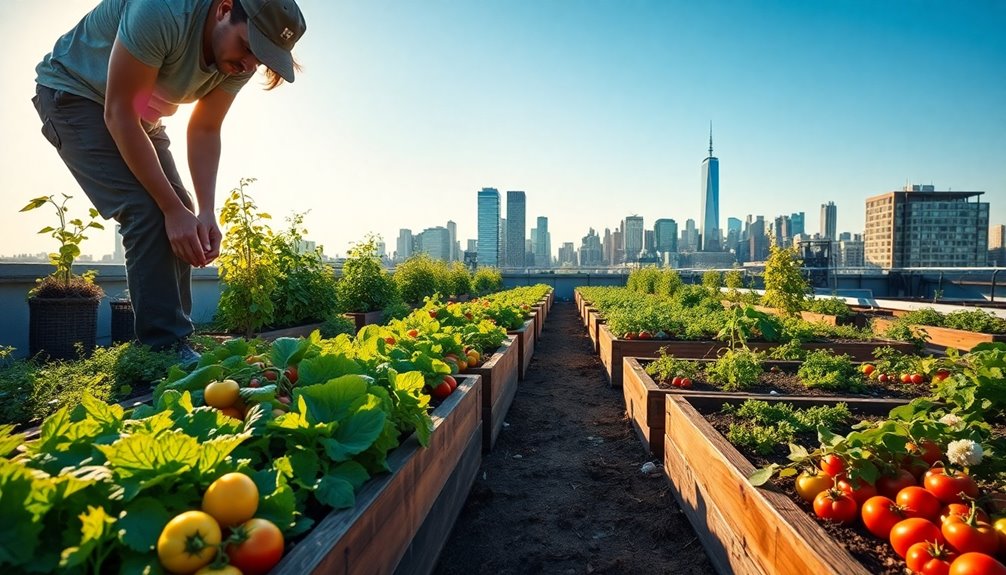If you’re sowing lettuce in July and want varieties that can handle the heat, try Buttercrunch, Little Gem, or Salad Bowl. Jericho Romaine and Red Sails also perform well in warm weather, staying tender and crisp even during hot days. These heat-tolerant options help prevent bolting and bitterness, ensuring a steady summer harvest. To learn more about growing these resilient lettuces and maximizing your garden’s yield, keep exploring the options available.
Key Takeaways
- Sow heat-tolerant varieties like Buttercrunch, Little Gem, Jericho Romaine, and Salad Bowl in July for summer harvesting.
- Choose varieties with disease resistance and drought tolerance to ensure resilience during hot weather.
- Prepare well-draining, organic-rich soil and maintain consistent moisture to promote healthy growth.
- Provide partial shade during peak heat to prevent bolting and heat stress.
- Regularly monitor and harvest early for crisp, flavorful leaves during high temperatures.
Buttercrunch Lettuce
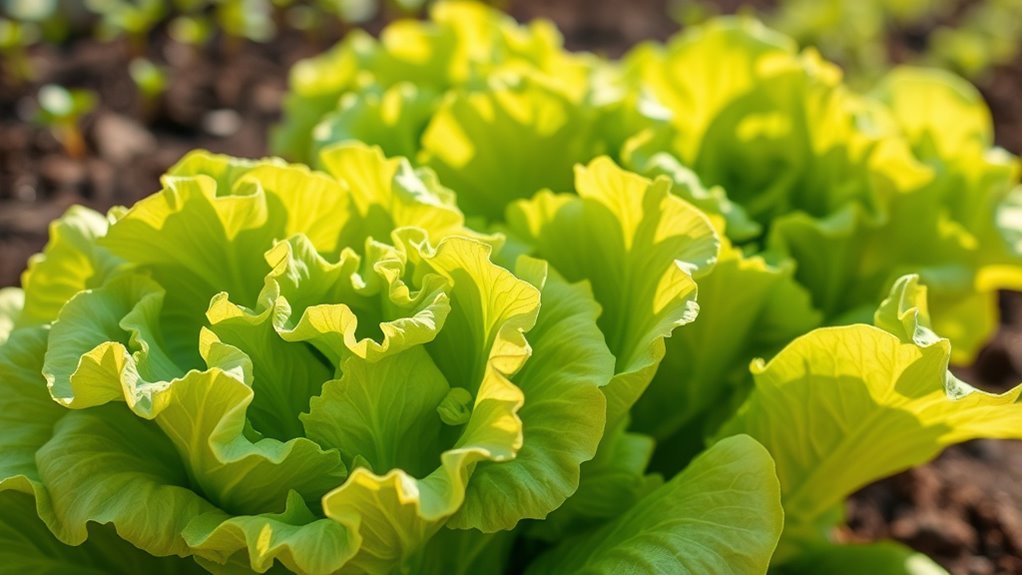
Buttercrunch lettuce is a popular heat-tolerant variety known for its crisp texture and sweet flavor. To guarantee healthy growth, focus on disease prevention by practicing crop rotation and avoiding overcrowding, which can lead to fungal issues. Proper soil preparation is essential; loosen the soil and mix in compost to improve drainage and provide nutrients. Test your soil’s pH and aim for a slightly acidic to neutral range, around 6.0 to 7.0. You should also remove any weeds or debris before planting to reduce disease risks. When planting, space your seeds adequately to promote airflow and prevent moisture buildup. Additionally, using self watering plant pots can help maintain consistent moisture levels and support healthy growth during hot weather, resulting in crisp, flavorful leaves throughout the season. Incorporating disease prevention strategies can further protect your lettuce from common pests and illnesses.
Jericho Romaine
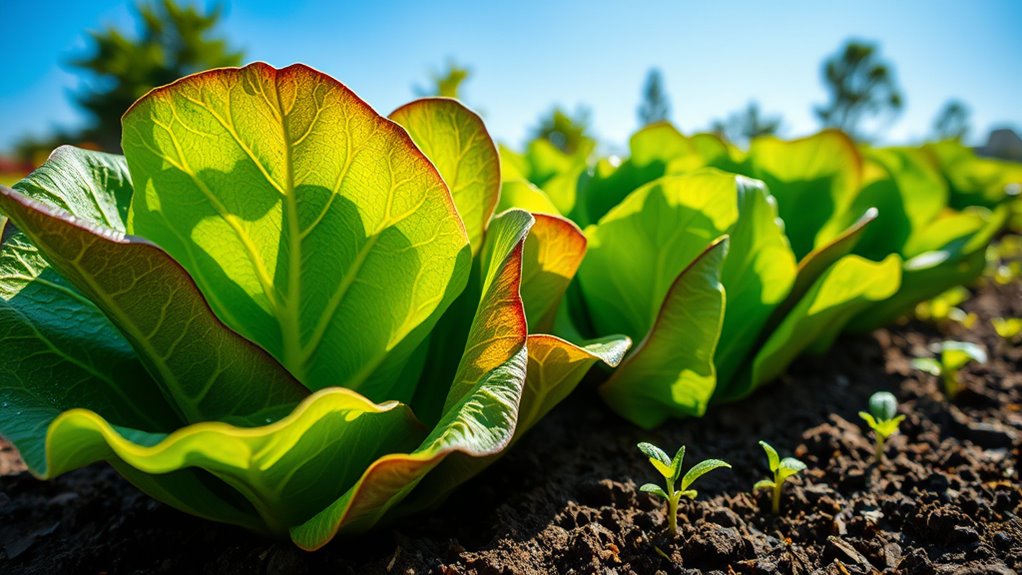
Jericho Romaine is an excellent choice for gardeners seeking a heat-tolerant lettuce variety with robust flavor and crisp texture. Its resilience to high temperatures makes it ideal for summer sowing in July. Growing Jericho Romaine supports biodiversity conservation by encouraging diverse planting practices that benefit local ecosystems. Additionally, cultivating this variety can improve soil health, as its deep roots help aerate the soil and reduce erosion. Heat-tolerant crops are increasingly important in the context of climate change, ensuring reliable yields even during periods of extreme heat. By choosing heat-tolerant varieties like Jericho Romaine, you contribute to sustainable gardening practices that promote ecological balance. Its adaptability to warmer conditions ensures a steady harvest, even during peak heat, helping you maintain a continuous supply of fresh lettuce. This variety combines flavor, durability, and environmental benefits, making it a smart choice for eco-conscious gardeners. Moreover, selecting resilient crops can minimize the need for excessive regulatory compliance measures, simplifying the gardening process. Proper crop selection also supports climate resilience, which is crucial in adapting to changing weather patterns. Incorporating heat-tolerant crops into your garden can also serve as a model for sustainable agriculture, encouraging broader adoption of eco-friendly practices. Understanding the importance of plant genetics can further aid in choosing resilient varieties that withstand environmental stresses.
Salad Bowl Lettuce
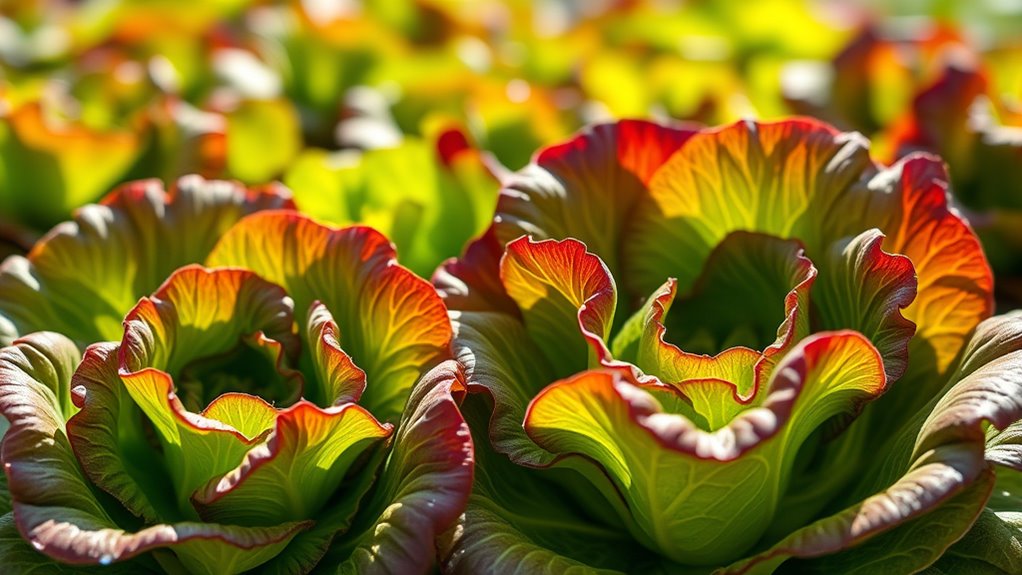
Salad Bowl Lettuce is known for its impressive heat resistance, making it a great choice for warmer climates. To get the best growth, you should provide it with well-drained soil and consistent watering. Knowing the right harvest and care tips will help you enjoy fresh, tender leaves throughout the season. For optimal flavor and texture, consider seasonal flavor blends that can be incorporated into your salads. Additionally, understanding planting schedules can inspire creative ways to enhance your gardening experience with themed garden projects.
Heat Resistance Features
Because salad bowl lettuce is often grown in warm conditions, breeders have developed varieties with specific heat resistance features. These include enhanced disease resistance and drought tolerance, helping your plants thrive despite heat stress. The varieties are bred to resist common diseases like downy mildew and lettuce mosaic virus, reducing crop loss. Drought-tolerant traits ensure your lettuce stays crisp and fresh during dry spells. Here’s a quick overview:
| Feature | Benefit |
|---|---|
| Disease Resistance | Less vulnerability to infections, healthier plants |
| Drought Tolerance | Maintains leaf quality in dry conditions |
| Heat Shock Proteins | Protects cells from heat damage |
| Leaf Cooling Traits | Reflects heat, keeps leaves cooler |
| Rapid Growth | Faster maturity, reduces heat stress impact |
Understanding plant resilience can further enhance your success in growing heat-tolerant varieties.
Optimal Growing Conditions
To achieve the best yields and quality, you need to provide salad bowl lettuce with ideal growing conditions. Start by planting in well-draining soil enriched with organic soil amendment to guarantee nutrients are available. Maintain consistent moisture levels and avoid water stress, especially during hot weather. Companion planting can help improve growth; for example, planting lettuce near radishes or carrots can deter pests and promote healthy development. Keep temperatures moderate and provide partial shade during the hottest part of the day to prevent bolting. Adequate spacing ensures airflow, reducing disease risk. Regularly monitor soil moisture and adjust watering accordingly. By optimizing these conditions, you’ll create an environment that supports lush, tender leaves and a high-quality harvest.
Harvest and Care Tips
After establishing the right growing conditions, harvesting your heat-tolerant lettuce at the right time guarantees maximum flavor and freshness. To guarantee ideal quality, monitor your plants and pick leaves when they’re tender and crisp. Here are some care tips:
- Use companion planting with herbs like basil or marigolds to naturally repel pests and support healthy growth.
- Practice regular pest management by inspecting leaves for insects and removing them promptly.
- Harvest early in the morning for the best flavor and texture.
- Keep the lettuce well-watered and avoid overexposing it to direct sunlight during the hottest parts of the day.
- Incorporate plant tuning techniques to optimize your growing environment for better resilience and yield.
- Selecting heat-tolerant lettuce varieties can significantly improve your success during the hot summer months.
- Ensuring proper soil conditions can also enhance growth and resistance to stress during high temperatures.
- Utilizing heat-tolerant varieties not only extends your growing season but also helps maintain consistent harvests despite fluctuating weather patterns.
- Adjusting gear shifting on your watering equipment or tools can improve efficiency when tending to your garden during hot weather.
Little Gem Lettuce
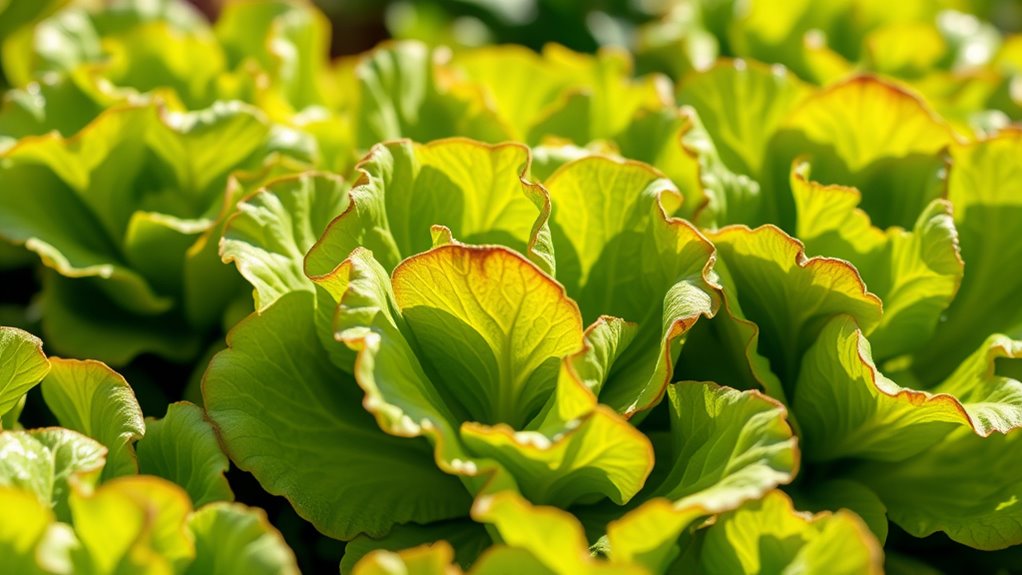
Little Gem lettuce thrives in warm weather, making it a great choice for hot climates. To guarantee healthy growth, you should provide well-drained soil and consistent moisture. When harvesting, pick the heads early in the morning for the best flavor and crispness.
Subheading 1: Ideal Growing Conditions
Little Gem lettuce thrives best when grown in full sun with well-draining soil that’s rich in organic matter. To guarantee growth, consider these key factors:
- Use soil amendments like compost to boost fertility and improve structure.
- Practice companion planting with herbs like dill or radishes to deter pests.
- Ensure consistent moisture but avoid waterlogging for healthy roots.
- Maintain soil pH between 6.0 and 7.0 for ideal nutrient uptake.
- Incorporating soil testing techniques such as soil testing can help optimize soil conditions for better growth.
Subheading 2: Harvesting Tips
To guarantee you get the best flavor and texture from your Little Gem lettuce, proper harvesting timing is key. Harvest when the heads feel firm and have reached the desired size, usually about 60–70 days after planting. Keep pest management in mind; inspect regularly to catch pests early and prevent damage that can affect quality. Good soil preparation before planting ensures healthy growth, making harvesting easier and more successful. Use sharp scissors or a knife to cut the head at the base, avoiding damage to nearby plants. Don’t wait too long, as overripe lettuce may become bitter or bolted, especially in heat. Proper timing, combined with diligent pest management and soil care, guarantees crisp, flavorful Little Gem lettuce at harvest. Additionally, maintaining optimal air quality around your garden can promote healthier plant growth and reduce disease risk. Regularly monitoring soil moisture levels helps prevent stress on the plants, ensuring consistent growth and better flavor. Furthermore, understanding the importance of plant stress management can lead to more resilient and productive crops.
Oak Leaf Lettuce
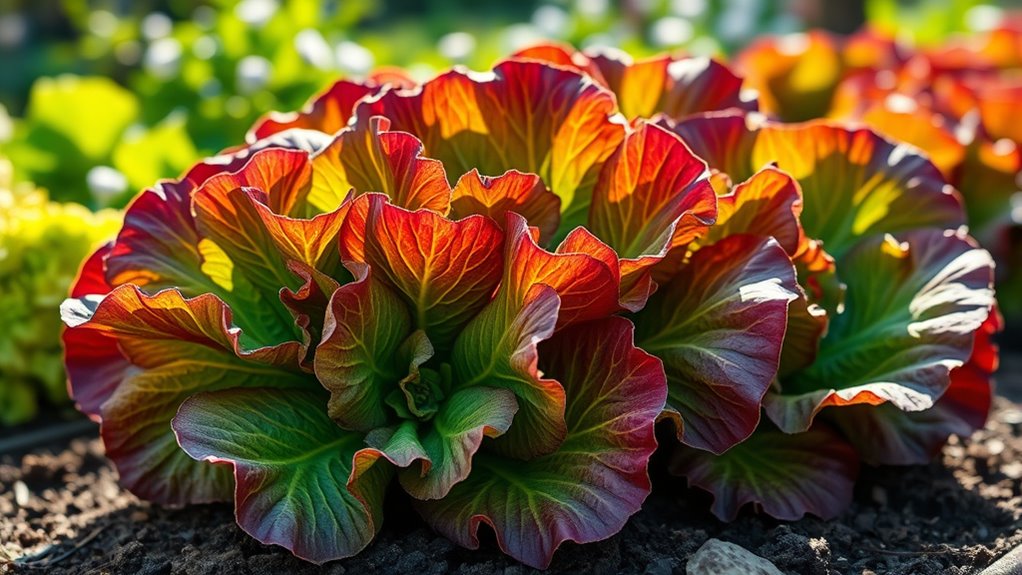
Have you considered how Oak Leaf lettuce can thrive in warmer temperatures? This variety is well-suited for summer sowing, especially if you focus on strategic practices.
Here’s how to maximize its success:
- Use companion planting with herbs like basil or marigolds to naturally deter pests.
- Guarantee good air circulation to reduce humidity and prevent fungal issues.
- Water consistently to keep soil moist but not waterlogged, aiding heat tolerance.
- Monitor for pests regularly, implementing integrated pest management to keep pests at bay without chemicals.
Black Seeded Simpson
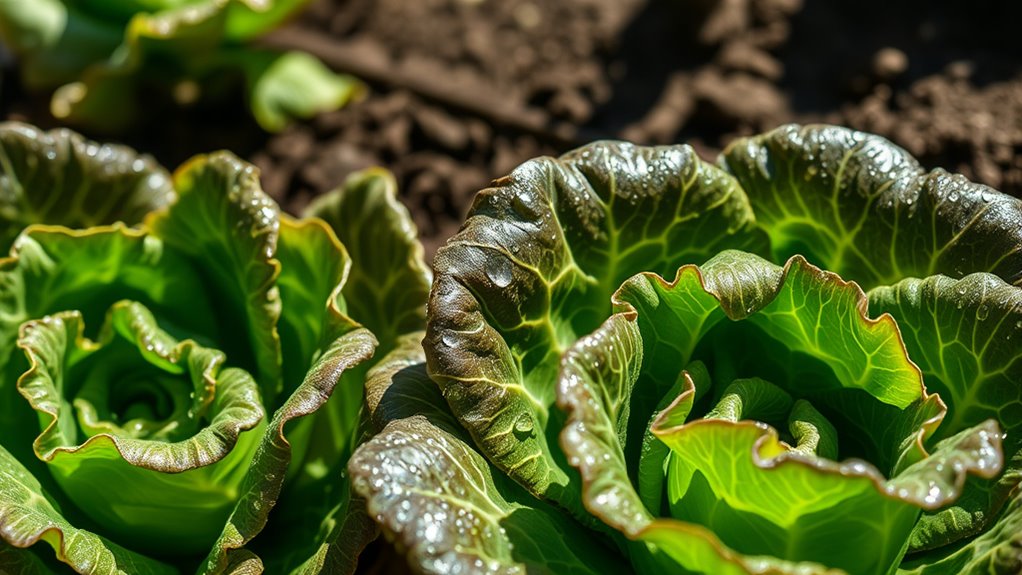
Black Seeded Simpson is an excellent choice for gardeners seeking a heat-tolerant lettuce that thrives in warm weather. Its crisp leaves stay tender even during hot July days, making it ideal for summer sowing. To give your plants the best start, incorporate soil amendments like compost or organic matter to improve drainage and nutrient availability. Proper soil preparation helps prevent issues caused by poor drainage, especially in high temperatures. Pest management is also essential; keep an eye out for aphids and slugs, and consider using organic controls to protect your crop. Regular monitoring and maintaining healthy soil create ideal growing conditions, ensuring your Black Seeded Simpson lettuce remains productive and flavorful throughout the season. With the right care, you’ll enjoy a bountiful, heat-tolerant harvest.
Red Sails Lettuce
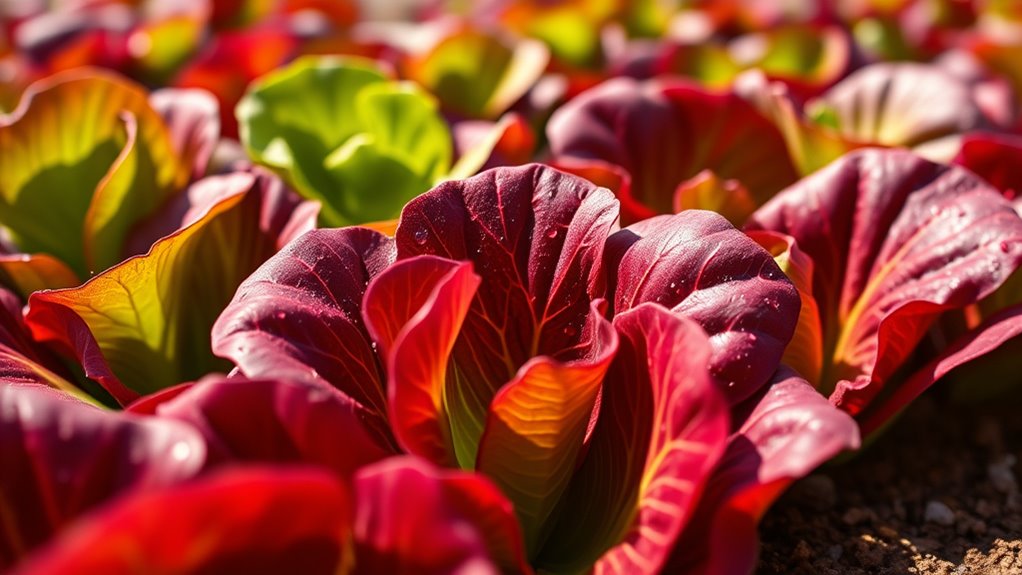
Red Sails Lettuce is known for its impressive heat resistance, making it a great choice for warmer climates. To get the best growth, you should plant it in partial shade and guarantee consistent watering. Understanding these growing tips helps you maximize its vibrant color and tender texture even during hot days.
Heat Resistance Features
Because heat tolerance is essential for maintaining quality during hot weather, Red Sails lettuce has developed several features that help it withstand high temperatures. Its resilience includes:
- A thick leaf canopy that reduces water loss and shields against sunburn.
- Rapid growth rate, enabling it to mature before heat stress worsens.
- Adaptability to a wide soil pH range, simplifying soil management.
- Compatibility with companion planting, which improves soil health and reduces pests, helping maintain ideal conditions during heatwaves.
These features allow you to better manage soil pH and incorporate companion planting strategies, promoting overall plant health. By understanding these heat resistance traits, you can improve your chances of a successful, high-quality harvest even in the hottest months.
Growing Tips for Red Sails
To successfully grow Red Sails lettuce, start by selecting a sunny location with well-draining soil. Proper soil preparation is essential; mix in organic compost to improve fertility and drainage. Red Sails benefits from companion planting, so plant it alongside radishes or carrots to deter pests and enhance growth. Keep the soil consistently moist but not waterlogged, watering regularly during hot weather. Thin seedlings to prevent overcrowding, allowing airflow and reducing disease risk. Mulch around your plants to retain moisture and keep roots cool. Avoid planting Red Sails near herbs like basil, which may compete for nutrients. With proper soil prep and companion planting, you’ll promote healthy, flavorful lettuce that resists heat stress and matures quickly.
Lobjoit’s Green Lettuce
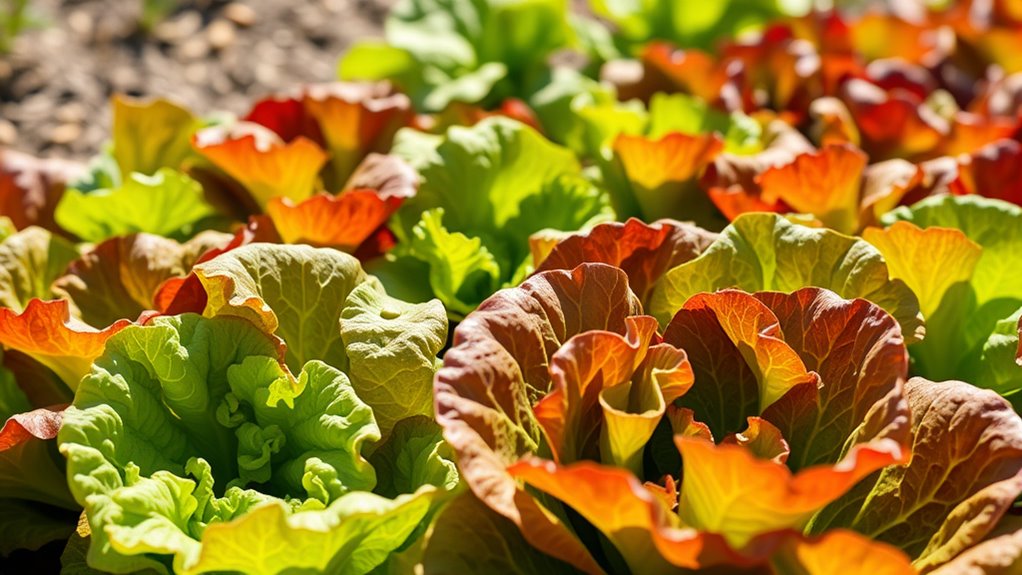
Lobjoit’s Green Lettuce stands out as a heat-tolerant variety that thrives in warmer conditions. Its resilience makes it ideal for July sowing, especially when soil pH levels are slightly acidic to neutral. To guarantee healthy growth, focus on pest management by regularly inspecting leaves for pests like aphids and slugs. Proper soil preparation is key, so amend the soil if necessary to maintain suitable pH levels. Here are some tips to maximize success:
Lobjoit’s Green Lettuce thrives in warm conditions with proper pH and pest management.
- Test soil pH regularly and adjust as needed.
- Use organic pest control methods to protect the plants.
- Sow seeds directly in well-draining soil.
- Provide consistent watering to keep the soil moist.
Jericho Romaine

Are you looking for a heat-tolerant lettuce that offers crisp texture and vibrant flavor? Jericho Romaine delivers just that, thriving in warm weather when others bolt. Its sturdy leaves stay tender and crunchy, making it perfect for summer sowing in July. To maximize growth, use companion planting strategies, such as pairing Jericho Romaine with herbs like basil or marigolds to naturally deter pests. This helps with pest management, reducing the need for chemical interventions. Jericho Romaine’s resilience allows you to enjoy fresh salads even during hot spells. Plus, its upright growth habit makes harvesting easy. With proper companion planting and pest control, you can ensure a healthy, productive crop that stands up to heat and pests alike.
Red Romaine Lettuce
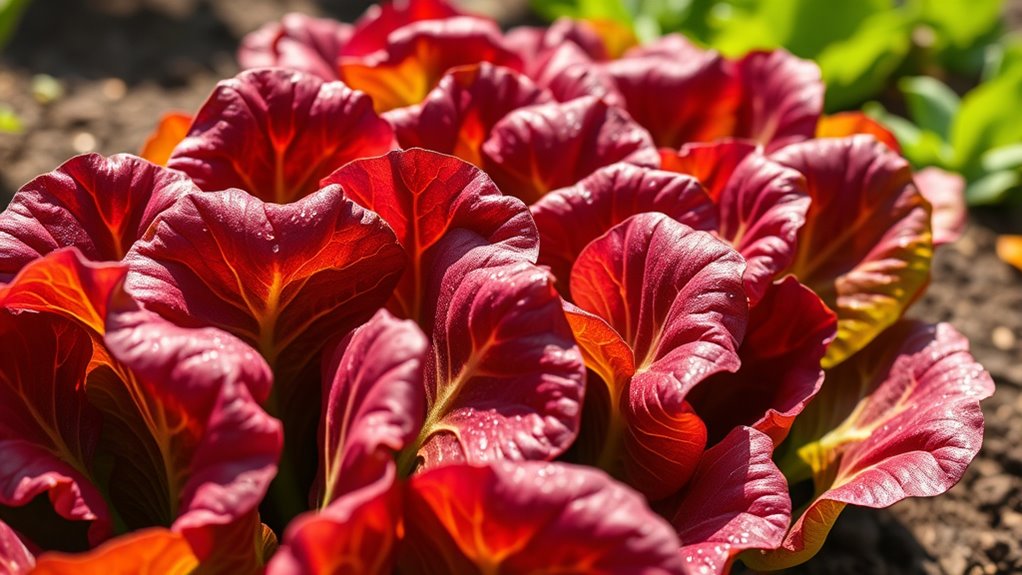
If you’re looking for a visually striking, heat-tolerant lettuce, Red Romaine Lettuce is an excellent choice. To maximize growth, start with proper soil preparation—enrich the soil with organic matter and ensure good drainage. This helps the plants stay healthy in hot weather. For pest management, keep an eye out for aphids and slugs; introduce natural predators or apply organic controls as needed. Red Romaine thrives in full sun but benefits from mulching to retain moisture and keep roots cool. When sowing in July, ensure the soil temperature is warm but not extreme. Regular watering and monitoring pests will help you achieve tender, crisp leaves. Red Romaine adds vibrant color and crunch to your salads, even during hot summer days.
Frequently Asked Questions
What Are the Key Characteristics of Heat-Tolerant Lettuce Varieties?
When choosing heat-tolerant lettuce varieties, you should look for key characteristics like crisp leaf texture and good drought resistance. These varieties thrive in hot weather because they maintain their freshness and don’t bolt quickly. You’ll find that their sturdy leaves and ability to withstand dry conditions make them ideal for summer planting, ensuring you get a healthy harvest even during high temperatures.
How Do Soil Conditions Affect Lettuce Growth in Hot Weather?
You should pay attention to soil conditions because they directly impact lettuce growth in hot weather. Make sure your soil has the right nutrients, like nitrogen, phosphorus, and potassium, to support healthy development. Also, maintain a balanced pH level, ideally between 6.0 and 7.0, to optimize nutrient absorption. Proper soil management helps your heat-tolerant lettuce varieties thrive, even during high temperatures.
Are There Specific Watering Techniques for Summer Lettuce Cultivation?
Think of watering your lettuce as giving it a revitalizing drink on a hot day. You should use drip irrigation to deliver water directly to the roots, minimizing evaporation and keeping the soil consistently moist. Mulching techniques also help retain soil moisture and regulate temperature. Water early in the morning or late in the evening to avoid evaporation, ensuring your heat-tolerant lettuce stays happy and healthy through the summer heat.
Can Heat-Tolerant Lettuce Varieties Be Grown in Containers?
Yes, you can grow heat-tolerant lettuce varieties in containers, making them ideal for container gardening and rooftop planting. Use large, well-draining pots filled with quality soil, and guarantee they get plenty of sunlight. Regular watering keeps the soil moist without waterlogging. These varieties handle warm conditions better, so you can enjoy fresh lettuce even during hot summer days on your balcony or rooftop garden.
What Are Common Pests Affecting Lettuce During Hot Months?
During hot months, you’ll face pests like aphids, slugs, and whiteflies that threaten your lettuce. To combat this, choose varieties with pest resistant traits and practice infestation prevention methods such as regular inspection, proper watering, and removing debris. Using organic pesticides and encouraging beneficial insects can also aid in safeguarding your plants. Staying vigilant and proactive ensures your lettuce stays healthy despite the pests.
Conclusion
Remember, a good harvest depends on planting at the right time. By choosing heat-tolerant lettuce varieties like Buttercrunch, Jericho Romaine, and Salad Bowl, you’re setting yourself up for success even in the summer heat. Sow these in July, stay attentive, and enjoy fresh, crisp salads all season long. As the saying goes, “The early bird catches the worm”—so don’t wait, get your garden started now for a plentiful summer harvest!

